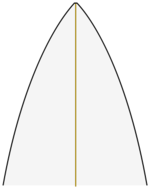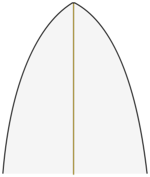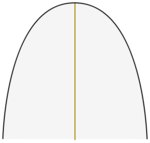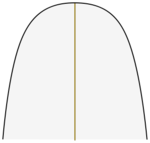Surfboards come in all shapes and sizes, some even come with a bit of surprises. But for the most part, surfboards fall into one of a few major categories. These groups distinguish the types of surfboards by their basic shape and how they are best ridden. The most common types of surfboards today include the: shortboard, longboard, funboard, fish, gun and hybrid. There are also a number of other designs which have a small following. Here is a brief description on each of the types of surfboards.
Types

|
Shortboard
The shortboard surfboard design reinvented high performance surfing in the 1970s and continues to allow surfers to push the boundaries of the sport. The shortboard is usually found at a length of under seven feet long. It will have a greater amount of rocker which allows it to surf in critical sections of the wave. It is most commonly seen with sharp noses, thins rails, and either three or four fins.
|

|
Longboard
This is the oldest and most traditional of modern surfboard designs. Longboards typically range from 8 feet to 12 feet long, at least 2.5 inches thick and twenty inches wide. This extra volume allows them to paddle incredibly well and catch waves with ease. A beginner should start on a longboard shape to learn wave selection, paddling technique, and turning basics. Expert longboarders are known for their smooth style, surfing in a very fluid manner.
|

|
Funboard/mini-mal
A funboard is a larger surfboards with a lot of volume but not quite that of a longboard. They typically range in from 6 feet to 8 feet long. The funboard is a perfect for surfers who want to transition to a smaller board while still maintaining additional paddling power and stability. The funboard can come in a variety of tail shapes, nose shapes, and foils. Funboards either have a single fin (like most longboards) or three fins (thruster style).
|

|
Fish
The fish design gained popularity in the 1970s and has origins in the knee-board. It is typically found shorter and wider than the shortboard and because of this it works very well in small mushy surf. A fish is a relatively flat surfboard with only a bit of rocker, allowing it to paddle very well and carry speed through flat sections of a wave.
|

|
Gun
This is the surfboard that you take out when the waves are huge. A typical gun ranges in length from 6’6” to 10’. The extra length allows a surfer to gain enough speed while paddling to catch the huge and fast moving waves. It is designed for big drops and handling very high speeds with good control. A gun will have a great deal of rocker and will most likely have three of four fins.
|

|
Egg
Eggs look like stubby, rounded, hybrid longboards. Common in smaller surf, these boards about having fun, not so much about performance and tricks. Eggs are a good choice for beginning surfers, because their width makes them pretty stable (read: easier to stand up!) and they work great on small waves.
|

|
Hybrid
A hybrid surfboard design mixes a few design elements from different board types. One common example mixes the characteristics and performance of a shortboard with the stability and tail design of a fish. This is a great board for medium size days or even just a heavier surfer who wants to surf a smaller board.
|

|
Tow-in
These boards are used only by the best in big-wave surfing. Tow-in boards are small and have foot straps, allowing a surfer to be dragged into a swelling wave at high speeds by a jet-ski. These are specialized, performance boards that make large, fast waves surfable.
|

|
Retro
The shortboard is a retro-inspired designs of the 70s, with shapes that can be somewhat strange. They are thick, with lots of surface in the up front, little curved, and rather short. We can find or pin dovetail with 1, 2, 3 or even 4 keels. You need a medium to get all the juice to retro, and move better in small to medium waves with little force. In bigger waves or very hollow not work as well.
|

|
Stand up paddle
Tables designed to move from standing at all times, both the wave and beyond. They are very wide and thick to support a person standing with stability. Used to propel a flexible paddle which also serves to maneuver on the wave. It’s a fun choice for small wave days with little force.
|
As you learn more about surfing you will hear about some other less common surfbaord designs. Some that come to mind are the bonzer, mini simmons and alaia. Each of these types excels in specific conditions.
Bibliography



